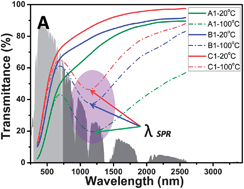Surface plasmon resonance induced excellent solar control for VO2@SiO2nanorods-based thermochromic foils†
Abstract
Transition-metal

* Corresponding authors
a
State Key Laboratory of High Performance Ceramics and Superfine Microstructure, Shanghai Institute of Ceramics, Chinese Academy of Sciences, Shanghai 200050, China
E-mail:
p-jin@mail.sic.ac.cn, p-jin@aist.go.jp
b Graduate University of Chinese Academy of Sciences, Beijing100049, China
c Shanghai University, School of Materials Science and Engineering, Shanghai University, Shangda Rd. 99, Baoshan, Shanghai 200444, China
d National Institute of Advanced Industrial Science and Technology (AIST), Moriyama, Nagoya 463-8560, Japan
Transition-metal

 Please wait while we load your content...
Something went wrong. Try again?
Please wait while we load your content...
Something went wrong. Try again?
Y. Zhou, A. Huang, Y. Li, S. Ji, Y. Gao and P. Jin, Nanoscale, 2013, 5, 9208 DOI: 10.1039/C3NR02221H
To request permission to reproduce material from this article, please go to the Copyright Clearance Center request page.
If you are an author contributing to an RSC publication, you do not need to request permission provided correct acknowledgement is given.
If you are the author of this article, you do not need to request permission to reproduce figures and diagrams provided correct acknowledgement is given. If you want to reproduce the whole article in a third-party publication (excluding your thesis/dissertation for which permission is not required) please go to the Copyright Clearance Center request page.
Read more about how to correctly acknowledge RSC content.
 Fetching data from CrossRef.
Fetching data from CrossRef.
This may take some time to load.
Loading related content
